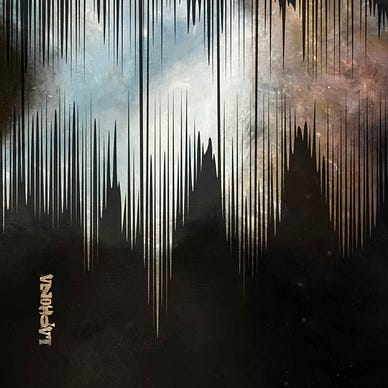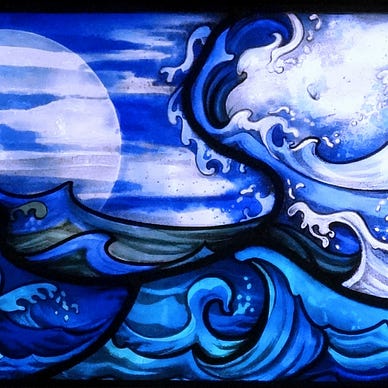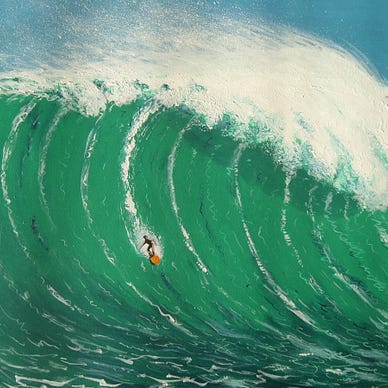INTERVIEW
The Powerful Story of Surf
An interview with John Tyner on Laphona’s debut album
When the heat dome struck the West Coast in 2021 and burned down an entire town, I channeled my conflicted feelings about summer into a playlist and then wrote about surf music every day for the month of July. I would have never guessed my daily devotions to surf music — compiled into a long read — would show in the top ten on Google search for History of Surf. Nor would I expect people to contact me over the last two years to mirror the same enthusiasm for a genre others have erroneously dismissed as a relic of the 1960s. In my examination of surf, however, I argue that surf is not a genre but a mode that flourishes today, merging with other genres while maintaining an ineffable, haunting call of the ocean’s vastness and restorative power.
On this writing adventure, I have been reminded again that when you put your work out there into cyberspace, you can create unexpected connections that sustain your work. When John Tyner read the article and reached out about his collaborative project Laphona and their new surf-infused debut, I had to write about the band.
Guitarist for ‘90s alternative Bay Area act MK Ultra, John Tyner started Laphona on a quest to explore what he calls “the narrative quality of post-punk/surf-infused sound.” Laphona’s first studio album IIIIIII (One Divided by Seven) is drenched in deep moods of surf and undulating time signatures that take on an emotive and compelling narrative. Each track is a story with accompanying tone poems that engender the sonic sea and landscapes they traverse.
Tyner’s responses to my interview questions have the same sense of an excursion — into the DNA of a song and through the power of story. He situates the spiritual pull of surf with the tempo of where it came. Like proper surf music, Laphona’s instrumental narratives are an extension of the ocean, and there is no doubt that the sense of its boundlessness allows the sound to cross over so well to desert/western themes and to the soundtrack.
Surf calls for a certain synesthesia — a crossover of the senses — an ecology of feeling and sound — that smells and tastes like the ocean. Tyner notes a similar synesthetic reaction to Todd Huth’s guitar as a kind of storytelling and touches on influences from Holst and Agent Orange to Morricone that, like Laphona, bring us right into the beating heart of surf.
JLM: I was drawn to surf when The Fat Boys covered “Wipeout” with the Beach Boys singing backup in 1987. The same year, Back to the Beach, a spoof on ’60s beach movies, was released, but it had an incredible soundtrack, including the Stevie Ray Vaughan/Dick Dale duet to “Pipeline” that hooked me. Did you have any gateway bands into Surf from when you were younger?
JT: It really came at me from left field. When I was young, I associated surf with the Beach Boys — and, by extension, this idea of goofy teens and beach parties. It just didn’t have an emotional draw for me, and I wouldn’t call it a gateway. It wasn’t until I began playing guitar that I started identifying themes in music that I would (much later) associate with surf. I remember loving the theme music for Bonanza and Hawaii 5–0 when I was a kid, and my mind being blown by Moricone-scored westerns — so dark, desolate, and emotive. I was developing a love for this lone cowboy western sound, which I would (much later) find to be a kindred spirit to surf.
My first ’surf music’ in the way I think about the term today, was in my early teens, skateboarding ditches to Agent Orange. They revived a handful of classic surf songs, trading in the jangly seashore quality for a high-energy rock/punk edge. It was perfect for skating (sort of the terrestrial version of surfing). At any rate, this is where I first became acquainted with the classic genre-defining works of Dick Dale, The Belairs, and The Chantays.
I remember loving the theme music for Bonanza and Hawaii 5–0 when I was a kid, and my mind being blown by Morricone-scored westerns — so dark, desolate and emotive.
JLM: In my brief history of surf, I defined it as a modality — rather than a genre — with a fascinating evolution and so many “micro-genres” today (indie, horror, pop). In your debut album IIIIIII, the hypnotic opening track “Desert Song” immerses us in noir, and “Stagedive” has a great surf-punk meets karate riff. How were you thinking about the tone of the songs when conceiving this album’s story and ordering the tracks?
JT: First, some props. That is an important and wonderfully written article! Such a rich, comprehensive, and personal journey down all the tendrils that found their way into or out of surf introduced me to my new favorite label, “Goth Surf” (which is how I like to think is the direction Laphona is heading in). You also bridge both sides of the Pacific with Terauchi’s exciting surf ala Shōnan and Dick Dales’ Middle Eastern scales. It’s great to hear the modality reflected off so many exotic cultures.
In considering the story of this first album, it was important to represent motifs that had personal meaning, and perhaps the songs could be seen as passages from an autobiography, though that wasn’t intended at the start. As to tone, I was chasing my excitement — being led down a path rather than directing it. Laphona is trying to find its tone/sound, and I’m not sure how you do that without going through the catalog of influences floating in one’s head. The order of songs — well, they have more to do with a progression of dynamics than content — when the tracks were ready, I ordered them with my first impression at that moment.
JLM: “Excited to Meet You” has a lot of great turns. It captures the jittery, pensive, excited feeling in the lyrics. When do the lyrics come into creating a new song?
JT: The lyrics often come after, though I know the subject right off the bat. The tone or expression of that first riff, the one you know will be the building block, carries so much DNA with it — you know what it’s going to be about. It can’t be about anything other than that.
JLM: What does surf music have that other “genres” don’t?
JT: It’s interesting that it’s not recognized as a genre with Spotify and Bandcamp and others — more of a sub-genre, but I agree with you and think of it more as a modality that has a place in loads of genres. That said, there is absolutely music that expresses the spiritual quality of actual surfing — proper surf music — which carries a certain longing and lives and dies out there on the waves. I am in awe of music that can achieve that level of reverence. When I hear bands mimicking the style but not picking up on the spiritual aspect of it, it falls flat for me.
The elements of surf, which find their way into so many styles — are VERY exciting. Surf guitar, for example, is so expressive — like an onomatopoeia — it literally sounds like ocean. That same quality with a slightly different vantage point sounds like the wide, empty desert. The use of the tremolo bar is also vital (and delicate) — it brings something organic and unpredictable — and when mixed with the big reverb, a splashy color palette you didn’t know existed. It’s so powerful to me — and an authority in the way it tells a story sonically.
That said, there is absolutely music which expresses the spiritual quality of actual surfing — proper surf music — which carries a certain longing and lives and dies out there on the waves.
JLM: You mention the album is comprised of tone poems. I love that you can read the words along with all the other details on the website—kind of like liner notes. Tell us your inspiration for connecting words with sound as tone poems.
JT: Other than MK Ultra, my music has always been instrumental but usually more de-contextual and detached. I was trying to break the tyranny of “proper songwriting,” and the result was often heady, circular, boring stuff — a phase I am still trying to break out of! Then came the discovery of creative writing and the ubiquity of the narrative. Everything is a story — our memories, deepest beliefs, fears, loves — all religion, science, laws, and truths. It’s absolutely how we relate to the world and can be quite powerful, as in my first introduction to the idea of tone poems.
I love Holst, and a few years ago, I picked up The Planets LP. It came with a set of tone poems on the back. I’d never heard the term before. As it was playing, I read one out loud to my wife, and as I recited the passage, my mind fused together the music with the poem, and the combination further reminded me of a cherished person we had recently lost…. it struck such a vulnerable spot in my soul that I literally broke down and sobbed out-loud, like wailed… rending of garments and all that. What was this!? Music nor lyrics had ever had that effect on me before. There is something about having to read it in your own voice rather than it being sung to you — it can take you places. I am very curious about exploring the line that separates song from soundtrack — which words conjure which sounds and vice versa — how much storytelling can be done without speaking.
I am very curious about exploring the line that separates song from soundtrack — which words conjure which sounds and vice versa — how much storytelling can be done without speaking.
JLM: Laphona appears to be a cool, multidisciplinary project that embraces video in really interesting ways by calling artists to collaborate. Returning to music again after a break, what approaches are meaningful for you in this streaming-based industry compared to when you were recording and touring with MK Ultra?
JT: MK Ultra was such a great experience and in the end helped me understand what I wanted. We were career-minded — as in, we rehearsed a lot, kept a consistent playing schedule, and promoted ourselves heavily — and I learned that I didn’t want to make a living from my art. Though I absolutely respect the dedication and commitment for those who make it their life, I’d rather pay the bills separately because the two intermingle in a way I don’t care about. I do miss playing live, though, and long to be able to do that again. This first effort is partly a calling card to find a couple of kindred music-making spirits to make that a reality.
I LOVE the freedom of the streaming experience and the ability to self-distribute. Also, to collaborate — to work with video artists and explore soundtrack work with a surf/punk sensibility. I once saw Tom Verlaine perform live instrumentals while short films by Man Ray were projected. It was amazing! I want to do that — I want Laphona to do that. If and when we ever perform live, there will be video with narratives.
JLM: Tell us about your moment of inspiration hearing the band The Tremolo Beer Gut around the same time you were reading Rick Rubin’s The Creative Act. (And thank you for introducing me to this righteous band)!
JT: I had sort of given up on music for some years. I needed to clean out, clear out, and start anew. These two wonderful shamans appeared and helped me evolve. All of the songs on the album came after.
When I first heard The Tremolo Beer Gut, I remember thinking, “these guys are doing whatever the F they want”! With huge, dark surf guitars, weird chord changes, and undeniably catchy melodies, they were everything I ever aspired to be. They brought the instrumental surf sound to a new fuzzy place with a combination of nostalgia and reinvention. It represents artistic freedom to me.
Later, I had put together some promising material, but didn’t want the disappointment of rejection. I was sure I was going to keep it for myself. Step in Rick Rubins— The Creative Act taught me that Art isn’t an end result or thing you make — it’s a process and a way of living. It is a child and needs to be nurtured and then sent out into the world. Not for its sake, but for yours (and the world's). Why? Because you can’t move on until that happens. I only wish I had read his beautiful book 20 years ago.
JLM: Surf is such a great vehicle for showing the versatility of guitar. Who is one of your favourite guitarists? What is a technique of theirs you find inspiring?
JT: This question will get different answers on different days when I might be in different frames of mind. The first person I thought of is not a surf guitarist. Todd Huth (Primus, Sausage, Porch) first introduced me to the idea of the wicked and ugly being shiny and beautiful. It was back in the late 80s and the first time I heard his playing, I remember thinking his sound stimulated my other senses — like his riffs smelled like funky stilton, looked like melted plastic, and felt like the high you get right before coming down with sickness and tasted like crave-able canned fish. His fearless style was the first that informed me what “coloring outside the lines” might sound like. His walls of sound, jammy-pocket riffs, and atonal call/responses remind me of the horrible, beautiful chaos found in Picasso’s Guernica. I don’t think he characterizes surf guitar, but I want to bring that level of storytelling in my own work.
JLM: The last question is just your rite of passage among music fans: What’s the best live show you have ever seen?
JT: Peter Murphy at a tiny club in Sacramento sometime around 2010. Stasia and I were right there, 10 feet away from this tiny stage with him and his band. We were and still are huge Bauhaus fans — they practically defined our formative years. That night, they played ALL Bauhaus music — but with a powerful edge that not even the original article had. It was spellbinding. Peter jiggled, shook, crooned, and danced — his singing and physicality encompassed everything I love about live theater. I mean, he was like 60, and he looked 30 — lithe in movement and joking in between songs with a lit cigarette dangling despite it being illegal. What a show. I know he’s fallen on harder times now, but my gods, I have never been so riveted nor connected so directly with any single performance.



